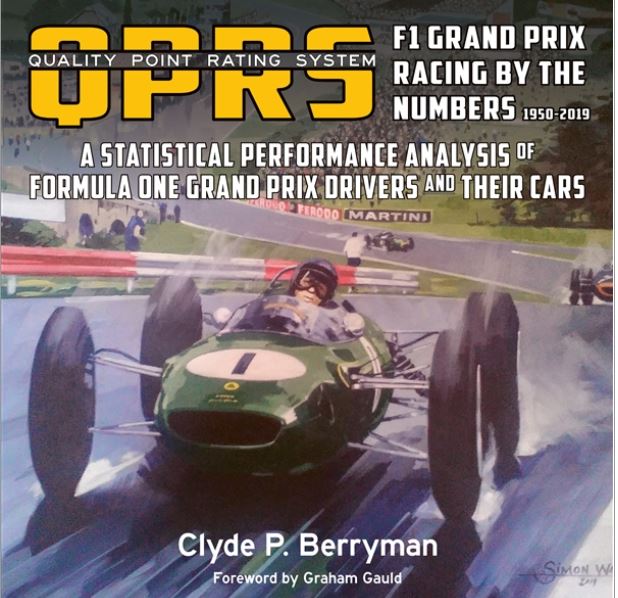
AVAILABLE APRIL 2021
WAS IT THE DRIVER, OR WAS IT THE CAR? That seems to be the age old, eternal question when motor racing enthusiasts gather to discuss the relative merits of Formula One Grand Prix drivers. Author Clyde Berryman devised a mathematical formula rating system, the Quality Point Rating System (QPRS), to objectively analyze and rate driver and car performances separately and came up with his own ranking system which was first featured in the July 1999 issue of F1 RACING Magazine.
This book is the updated and comprehensive QPRS study of Formula One Grand Prix racing drivers and cars from 1950 to 2019. It has an introductory section which discusses the principles behind the rating system and the major changes which have taken place over the evolution of F1, which often make direct comparisons quite difficult. Every chapter covers each decade with a short summary of the racing which took place, a QPRS ranking of the 10 best drivers and 10 best cars of the decade, and annual tables which provide the season calendar and the historical championship points, and the QPRS driver and car ratings for each year.
There are some all-time ranking tables and other pertinent analyses contained in summaries at the end of the book. In addition to maps of the many circuits used throughout F1 history, this massive 500-plus page volume features the exceptional artwork of some of the leading contemporary motor racing artists in the world.
- Hard cover with dust jacket
- 286 x 229mm (landscape)
- 528 pages
- More than 173 original art and 77 illustrated track maps

The fact that Porsche owes a not insignificant part of its legendary reputation to the Speedster makes this synoptic consideration of its entire history all the more interesting! It begins with a meeting between Professor Ferdinand Porsche and US importer Max Hoffman at the Paris Motor Show in 1950 and ends with the most recent Porsche Speedster in 2020.
The book entitled “Porsche Speedster Legends 1954-2020” will be published as a limited edition of 1954 books on 28 August 2020. This volume pays homage to the most beautiful and sought-after Porsche models of all time.
Special features in this book
- Detailed purchasing advice and price trends
- Extensive information about special models
- Unpublished documents and photographs for Speedster history
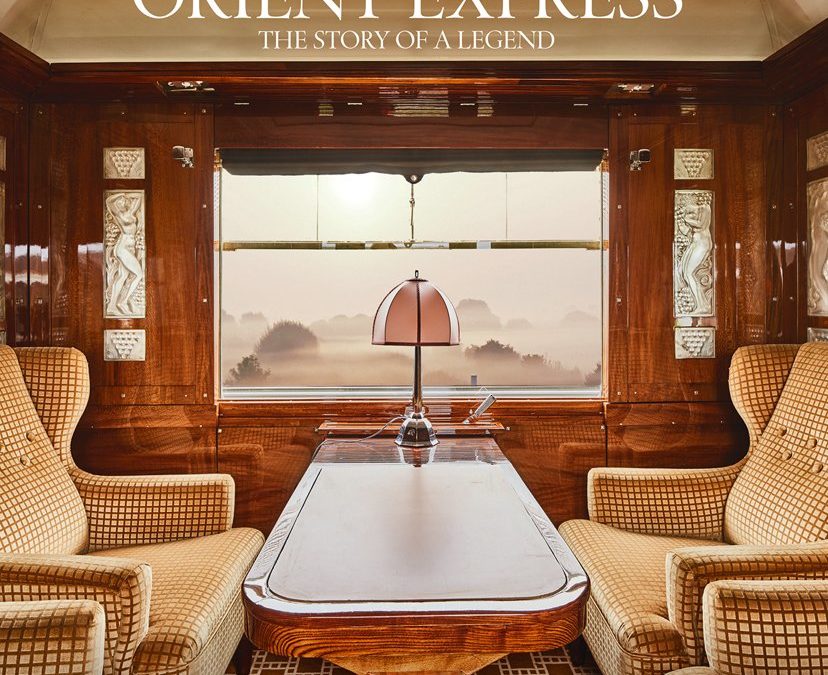
This beautifully illustrated book captures the history, the legends and the unique style of the most famous train on earth: The Orient Express
• With never-before-seen archival material
• With a preface by Sir Kenneth Branagh
“The Orient Express, in the collective imagination, embodies the golden age of travel. The fabrics, the silverware, the woodwork; their evocative fragrance… all contribute to this particular atmosphere, created by the best craftsmen of the time. The experience on board is absolutely unique…” – Sir Kenneth Branagh, from the foreword
The first train to connect Paris to Constantinople – the gateway to the Orient and epitome of all its associated desires and fantasies – the Orient Express was an immediate success. Quickly nicknamed ‘the king of trains, the train of kings’, it had already become a legend in its own time. This unique train and its celebrated passengers (both real and fictional) have become one of the great cultural icons of our times and have helped to create a limitless source of stories and fantasies to feed our imaginations. It’s a story told here through fabulous new photographs of the restoration workshops where the historic train carriages are being brought back to life, through archive photos of famous and exotic destinations, and portraits of the most famous passengers who were lucky enough to climb aboard.

Getting a Rover K-Series engine properly up and running can be a difficult task, but the result is always worthwhile. Rover K-Series Engine – Maintenance, Repair and Modification is a practical guide to keeping these unique engines in fine working order. The most well-known issue with the K-Series is the head gasket, and this book identifies common faults, before giving practical advice on how best to solve them. Step-by-step guidance on long-term engine maintenance is provided, in addition to the improvements required to prevent further problems. A K-Series engine is stripped down to examine its clever and interesting structure, and is rebuilt with improvements. Authors of over twenty automotive books, Iain Ayre and Rob Hawkins have combined their knowledge to bring you this book on the Rover K-Series engine. Topics covered include the history of the K-Series; common faults and solutions; full strip down and rebuild; the Rover KV6; modifications for power and reliability; electronics and programming and comparisons with similar engine options.

This new title in Veloce’s Enthusiast’s Restoration Manual series provides professional but easy-to-follow know-how on how to restore, improve and maintain your classic car’s suspension, steering and wheels. This book will familiarize you with the components of your car’s suspension and steering systems and their construction, it also takes a detailed look at refurbishing wheels and the choice of tires. The relevant restoration techniques are fully explained and illustrated with detailed step-by-step photography. How to Restore & Improve Classic Car Suspension, Steering & Wheels is based on articles from Europe’s leading classic car magazine, Oldtimer Market.
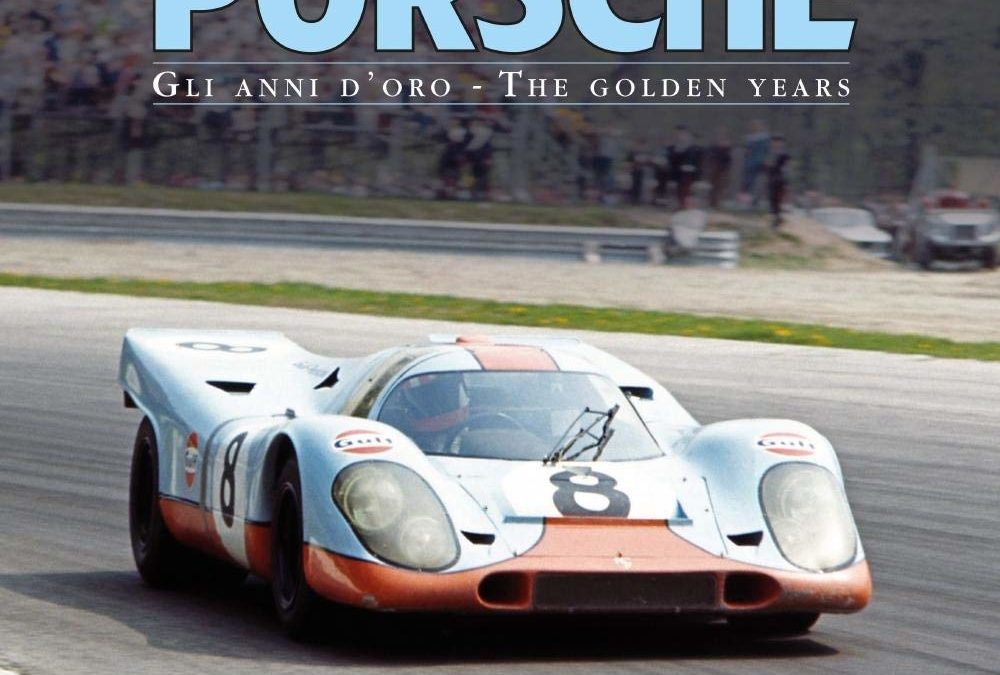
Iconic cars such as the 356s and the immortal 911s, extraordinary success stories in the classic endurance races, great champions and remarkable engineers. These are the principal ingredients of Porsche: The Golden Years, a book examining the full history of the legendary Stuttgart firm, with spectacular and previously unpublished images by photographer Franco Villani. The Porsche 356, with both closed and open bodywork, was the model that in 1948 officially inaugurated the catalogue of the celebrated Stuttgart firm. In that difficult period of reconstruction, Dr. Ferdinand Porsche, artificer of the car and founder of the marque, was already an undisputed authority in the automotive field for having designed the Volkswagen Beetle, the people’s car. The Porsche 356s were “legitimate offspring” of the Beetle and soon found favour with the public: they were sporting cars that were easy to use in everyday life. This is the true Porsche “DNA”, confirmed with the launch of the 901, or rather the 911 that first saw the light of day in 1963, a model that soon became a planetary success story, a car capable of traversing the decades while maintaining intact its appeal. The Porsche name also evokes the innumerable victories obtained in legendary endurance races such as the Le Mans 24 Hours and the Targa Florio, in the World Rally Championship and in the great African raids such as the Paris-Dakar, as well as in Formula 1 as an engine supplier to McLaren in the early ‘80s.
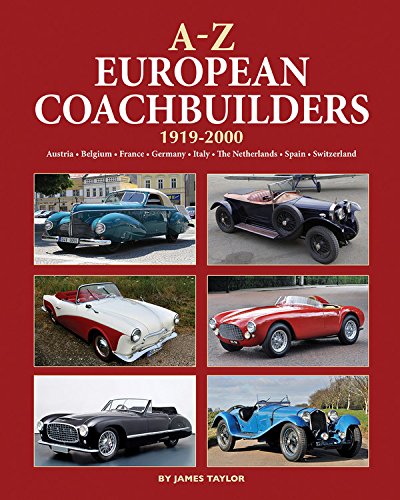
Coachbuilding is a subject of great fascination for many automotive enthusiasts, even though the golden age of individually coachbuilt bodies is now long in the past. From ACB of Paris (1934-91) to Zschau of Leipzig (1878-1939), by way of great names like Bertone, Pinifarina, Touring and Zagato, this is an alphabetical reference guide to the major coachbuilders of western continental Europe – Belgium, France, Germany, Italy, the Netherlands and Spain. The A-Z entries provide details of the history, activities and specialities of each coachbuilder, including the marques they bodied, while the book’s broad time span encompasses both the great era of hand-crafted bodies and the more recent field of conversions and special bodywork.

The Kellner Affair tells the fascinating story of some of the most influential people in the French luxury car business before the War and how they came together and fought bravely against the Nazi occupation force in Paris. It tells how they formed a resistance group and gathered intelligence ̶ how they were betrayed by double agents, and how they were executed in 1942.
These people included the famous coachbuilder Jacques Kellner, the designer Georges Paulin, and Walter Sleator, the director of Rolls-Royce France, who survived. The book goes deeply into their talent, their work, their lives, their cars, their loved ones and relies on newly discovered archive material as well as private documents that have never previously been published.
The Kellner Affair is the first factual account of these tragic and gripping events: what happened, how it happened, who was to blame, who was punished, and who was not.
Volumes I and II also include an in-depth discussion of aerodynamic cars, the famous streamlined designs of Georges Paulin, and the duplicitous way in which Walter Sleator assumed control of Rolls-Royce France after the Liberation. In addition, Volume III contains a large portfolio of period images of Kellner-bodied cars such as Hispano-Suiza, Renault, Rolls-Royce, Bugatti, Farman, and many more, along with period articles and a wealth of design drawings as well as facsimile reprints of Kellner brochures. The USB flashdrive in Volume III links to 401 pages of scanned source and reference material that document the book.
- 3-volume fabric-bound with inlaid photo (includes bonus material on USB)
- Fabric-bound slipcase
- Page count: 1,056
- Flash Drive: 401 pages (click here for USB drive/stick instructions)
- Total images: 1,568
- Flash Drive: 388 images
- Limited to 1,000 numbered copies signed by the authors
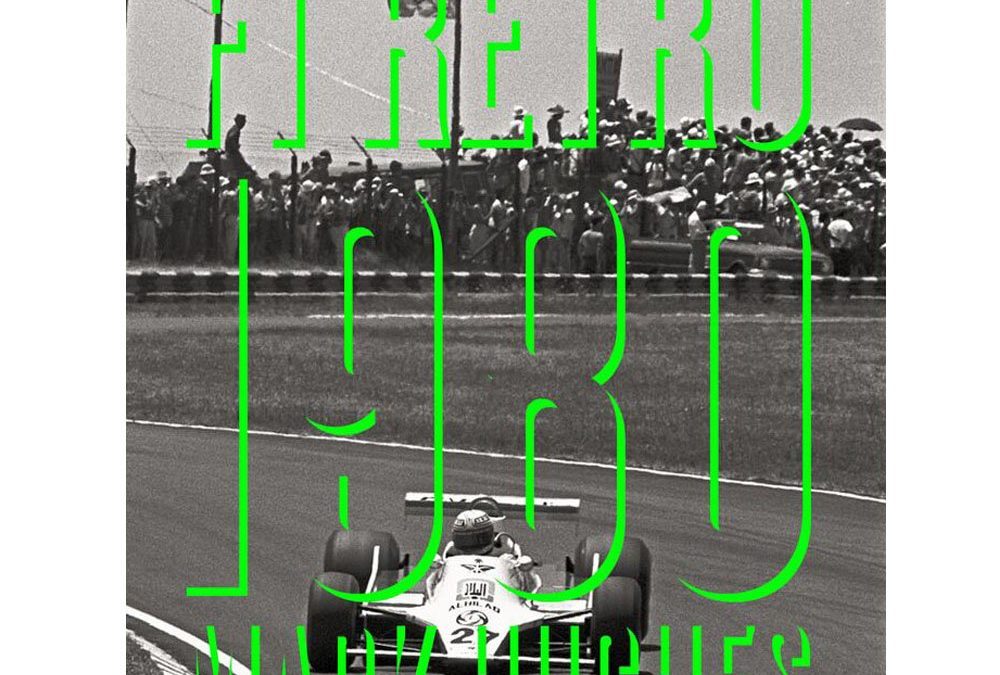
The much-anticipated second of Mark Hughes’ F1 Retro series of books that take an F1 season of the past and put it under the microscope using today’s knowledge. With this unique approach F1 Retro 1980, published by Motor Sport magazine, makes an absolutely last-word, multiple-layered account of the romance, politics, personalities and technicalities of the 1980 season. All wrapped in a beautifully-produced and designed package that is a tactile and visual delight and a wonderful companion to F1 Retro 1970. Evocative and in-depth, F1 Retro 1980 puts the events of the time into a historical perspective as it tells the fascinating story of a defining season in the sport’s history. This is done from multiple perspectives: -Vividly evoking the era, one that cast the drivers in the role of ruthless mercenaries in a time of commercial electrification, placing them between the closely-bonded romantics of a previous dangerous age and the data-driven professionals of today. -The highly charged political battle for the sport’s control that would come to define the F1 of the 21st century. -The way that this dovetailed with two immature but potent technologies, turbo charging and ground effect aerodynamics. -Race-by-race analysis with supporting data, highlighting car and team-mate performance comparisons. -Deep technical insights on the cars, engines and aerodynamics, the latter explaining the phenomenon of ground effect, why each car worked or didn’t. -Driver and engineer interviews, including world champion Alan Jones and the creator of his Williams FW07, Patrick Head. -A 21st century CFD analysis of the championship-winning Williams FW07. -Reproduction of contemporary Williams documentation and technical drawings. Rich in anecdote, analysis and insight, F1 Retro 1980 is much more than just a nostalgic trip – although its beautifully presented photography makes it that as well – but a unique and definitive treatment of a snapshot in F1 history.
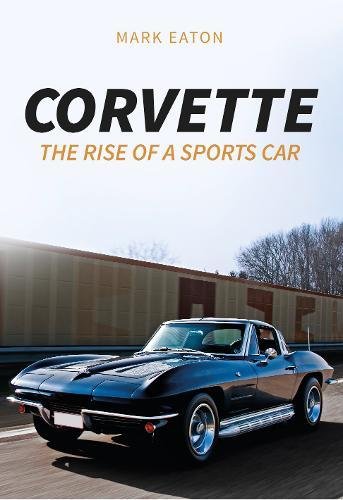
This book examines how the Corvette measures up to the sports car criteria and makes comparisons with the mainly foreign competition. It asks whether the Corvette was a sports car or a “muscle car: and explores the Corvette sub-culture in the U.S. where the large car was woven into the fabric of society. It follows the evolution of the shape of the car and how this was affected by both time and geography, and it analyzes the social issues such as the craving for fun in both good and bad times and the effects of fuel crises and fuel emissions regulations. The author examines the various styling changes of the cars as they evolved over the decades as well as some of the revolutionary engineering changes that set new standards in the U.S. automotive industry, and explains how the Corvette survived the financial challenges to Chevrolet and General Motors.
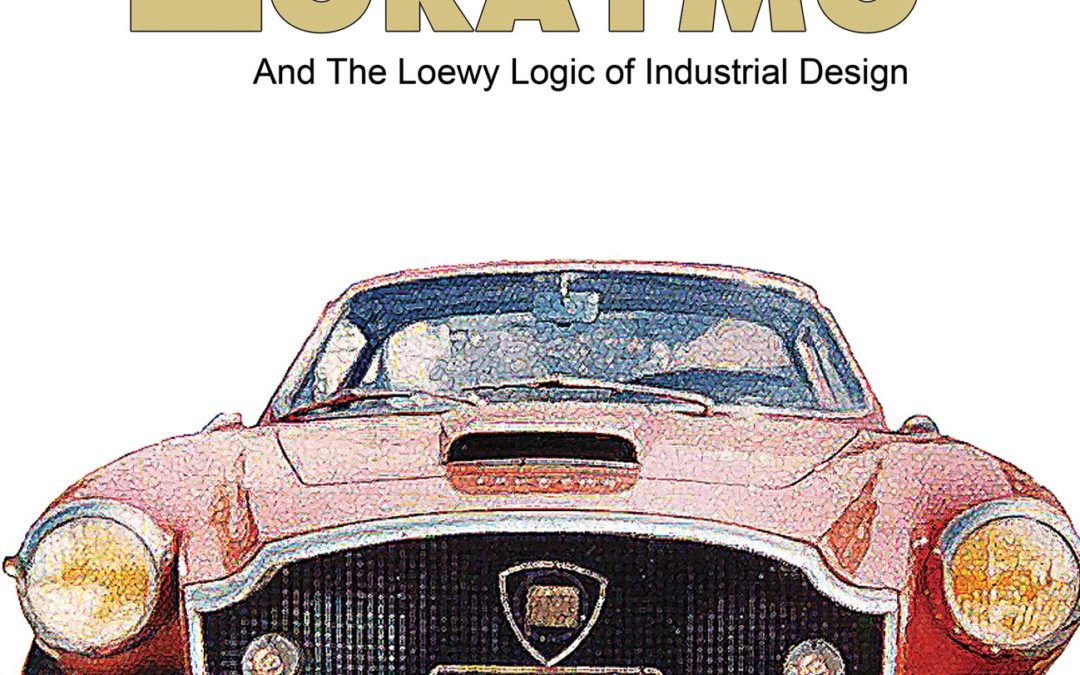
The new book Lancia Loraymo from Fetherston Publishing LLC can best be described as an automotive mystery. Researched and written by journalist Brandes Elitch, it follows the development of the Lancia Loraymo, which was designed by the Father of Industrial Design, Raymond Loewy, as a personal project to advertise the Loewy brand. Built for the 1960 Paris Motor Show, where it was the hit of the show, the Loramyo was reminiscent of the fabulous cars that graced the Concours d’Elegance circuit in pre-war France. The chassis was specially prepared by the Lancia factory to showcase the new Flaminia series with a handmade aluminum body by Carrozzeria Moto. It garnered enormous publicity for a few short years, and then disappeared. Like the intrigue that surrounds the fabled Chrysler Norseman dream car, the missing Loramyo came back to life when it was found 20 years later in a scrap yard in Sacramento, CA, missing its original drive train and scheduled to be crushed. This is the story of the birth, near-death, discovery and restoration of Loewy’s Loraymo. Elitch follows the trail, recalling the history of the car, its illustrious designer, and the Lancia marque, as it pertained to Loewy’s perspective on automobile and industrial design of the time. This historical journey wraps up with the design of the Studebaker Avanti, which utilized many of the design cues from the Loraymo. This is a fascinating story of one of the most mysterious show cars of the post-war period. It is set in large type to accommodate the baby boomer readers and is well documented in 128 pages with a 100 photos and illustrations. It is only available in a limited hardback edition of 500 copies.
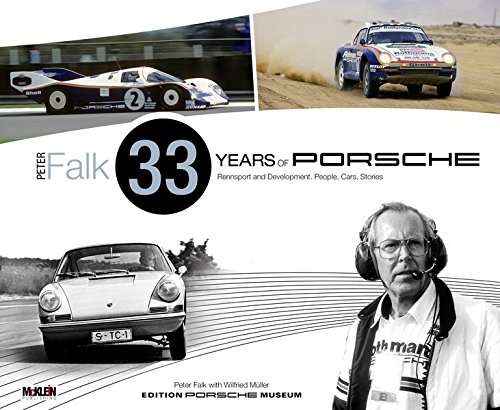
AWAITING PUBLISHER RE-PRINT
Limited Edition Available here
Peter Falk and Porsche, 33 years of passion and devotion: As their race director and one of the leading figures in their experimental department, Peter Falk contributed significantly to the character of the sports cars from Stuttgart-Zuffenhausen – both on the race track and on the road.
From the first 901 right through to the very last air-cooled Type 993, every Porsche 911 bears the signature of Peter Falk. He joined the company in 1959 and quickly rose through the ranks to head various testing departments. In the mid-sixties, Falk also took over the tactical and technical leadership of the factory’s “Rennsport” team. In 1981, he was appointed as race director and led Porsche throughout its most successful era of competition. “His” team won at Le Mans, became World Sports Car Champions, conquered the Paris-Dakar Rally, and was victorious in Formula 1 with the TAG Turbo engine.
In this book, Peter Falk tells of his years with Porsche. A highly respected person in the world of engineering, he relates how it all began at Porsche – when race drivers and engineers huddled together in a shepherd’s hut at Weissach to discuss suspensions, what the Porsche crew experienced during endless testing adventures in both the Arctic Circle and the Sahara, how the race cars at Le Mans roared to the start over country roads, and how a test drive with a Porsche 908 almost cost him his life. He shares his views on every Porsche race car, from the 904 Carrera GTS to the 962C, and describes the race drivers who competed during his reign: Hans Herrmann, Jacky Ickx, Vic Elford, Derek Bell, Hans-Joachim Stuck and Jochen Mass to name just a few. Falk provides a good, long look into the inner workings of Porsche.
Peter Falk shared his personal Porsche stories and fascinating insights with the author Wilfried Müller. The images in this book come from Peter Falk’s private collection, from the Porsche Historical Archive in Stuttgart-Zuffenhausen, and from the vast cache at McKlein Photography. Along with the contributions from former colleagues and race drivers, these images and stories give an in-depth portrayal of Peter Falk’s 33 years with Porsche.

Three quarters of a million people are in a plane somewhere right now. Many millions travel by air each day. For most of us, the experience of being in an airport is to be endured rather than appreciated, with little thought for the quality of the architecture. No matter how hard even the world’s best architects have tried, it is difficult to make a beautiful airport.
And yet such places do exist. Cathedrals of the jet age that offer something of the transcendence of flight even in an era of mass travel and budget fares. Here are twenty-one of the most beautiful airports in the world.
The book features:
Wellington International Airport, ‘The Rock’ shaped like the dangerous cliffs of a local legend
Kansai International Airport, Renzo Piano’s gigantic project built on three mountains of landfill
Shenzhen International Airport, a manta ray shaped terminal putting this booming region on the map
Daocheng Yading Airport, the world’s highest civilian airport in the middle of the Tibetan mountains
Chhatrapati Shijavi International Airport, rising from the slums of Mumbai like a Mogul palace
Queen Tamar Airport, a playfully iconic modern airport nestled in the mountains of Georgia
King Abdulaziz International Airport, the gateway to Mecca resembling a Bedouin city of tents
Pulkovo Airport, mirroring the city of St Petersburg with bridges, squares and art
Berlin-Tegel Airport, ultramodernity, 1970s style
Copenhagen Airport, an icon from the golden age of air travel
Franz Josef Strauß Airport, sober and easy to negotiate, Munich’s model airport
Paris Charles du Gaulle Airport, the brutalist icon that launched the career of airport architect Paul Andreu
London Stansted Airport, Norman Foster’s return to the golden age of air travel
Lleida-Alguaire Airport, a relic of Catalonia’s early 21st century building boom
Madrid-Barajas Airport, Richard Rogers and Antonio Lamela’s calm, bamboo-panelled Terminal 4
Marrakesh Ménara Airport, a blend of 21st century construction and traditional Morrocan design
Santos Dumont Airport, Rio de Janeiro’s modernist masterpiece
Carrasco International Airport, Rafael Viñoly’s design inspired by the sand dunes of his native Uruguay
Malvinas Argentinas International Airport, echoing the mountains and glaciers of Tierra del Fuego
John F Kennedy International Airport, Eero Saarinen’s glamorous jet-age TWA terminal
Spaceport America, a vision of the future in the New Mexico desert

When we think of Porsche, we think of at least two things: that beautiful, distinctive design, and that incredible speed.
The new hardcover book, 111, Porsche Stories That You Should Know is filled with tales and historic photographs that reveal many fascinating aspects of this remarkable car, such as:
-
behind the scenes in a desert camp during the Paris-Dakar Rally of 1984, waiting for René Metge to appear in the Porsche 911 Carrera 4×4;
-
what happened to the very first two Porsches to arrive in Australia, a chestnut brown coupé and a fish-silver 356 cabriolet with the first right-hand drive;
-
how the racing department tested and tortured Porsche brakes on the 21-km downhill run at Mont Ventoux…
…And 108 more stories of heroic drivers, grueling races, dramatic victories, and unique personalities that have been drawn to Porsche since the early days when 23-year-old Ferdinand Porsche started his first job in the automotive industry in 1899.
Author Wilfried Müller writes, “This is a book full of Porsche Stories. Not a history book, and not a work of reference – but 111 crisp and delicious stories to amaze you, to make you smile, to delight you.”
For lovers of this car in all its forms, for those who appreciate astounding engineering, and for those who simply appreciate its beauty, the Porsche comes to life in this uniquely wonderful book.

SIGNED BY THE AUTHOR
The Inside Story:
Roland Kussmaul has been involved with developing every racing car Porsche has built since 1975, from Le Mans-winning sports cars, to Paris-Dakar Rally-winning cars, to winning Indy cars, to the complete decade-long dominance of Group C prototypes, to the GT3 Cup and GT3 RSRs, as well as the famous RS Spyder. If you’re interested in hearing the inside story of how these successes came to be, told as a narrative, the truths are in this book.

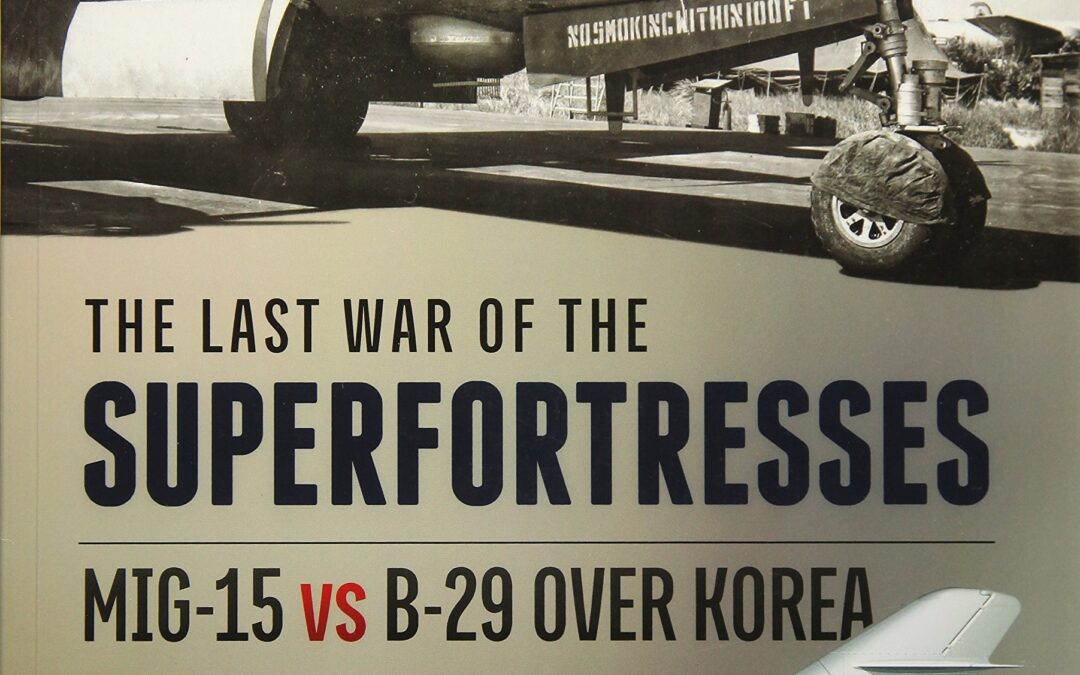
This work is an attempt by the authors to give as full and detailed a history as possible of the confrontation between Soviet fighters and the principal strike force of the United States Far East Air Force – the B-29 ‘Superfortress’ bombers during the course of the Korean War between 1950-1953. Military documents, which the authors have studied over many years of work in the Central Archive of the Ministry of Defense of the Russian Federation in Podolsk – as well as published Western sources – form the basis of this book.
The recollections of pilots who served in the 64th Fighter Air Corps, and who participated personally in the events described, are also widely used. Almost all the battles that took place between Soviet fighters and the ‘Superfortresses’ are analyzed in detail; the authors have, on the basis of a comparison of Soviet archive documents and data from published Western sources, attempted to clarify the actual losses on both sides in these battles. Particular attention has been paid to key events in the history of the confrontation between the MiG-15 and B-29 such as the air battles of April and October 1951, which had a significant impact on the course of the Korean War and influenced the development of military aviation in both the USSR and the USA. Following the encounters on the approaches to the bridges at Andung of 12 April 1951 Strategic Air Command decided against using ‘Superfortresses’ close to the area around the MiG bases. The outcome of a series of air battles from 22 to 27 October 1951 – the most famous of which was the battle between MiGs and B-29s in the area close to the airfield at Namsi on 23 October (‘Black Tuesday’) was a ban by Strategic Air Command on daylight operations by ‘Superfortresses’ in the Soviet fighter’s zone of operation. These battles also influenced the technical policy of the United States Air Force in relation to strategic bombers.
Extensive losses in combat with the MiGs served as one of the most influential arguments for curtailing the piston engine B-36 and B-50 bomber programs and boosting development of one of the most famous aircraft in the history of global aviation – the B-52 ‘Stratofortress’. Night operations, to which the B-29s and subsequently Soviet fighters were transferred, are also analyzed in detail in this book. These nocturnal operations culminated in the air battles of December 1952 and January 1953. After sustaining losses in these battles that were comparable to those of October 1951 the ‘Superfortresses’ would subsequently only carry out nocturnal sorties to the MiGs’ zone of operation in poor weather conditions. In this work, the authors have analyzed the advantages and the disadvantages of the La-11 and the MiG-15bis – the principal fighters of the 64th Fighter Air Corps – from the point of view of their ability to intercept the B-29s. Attention has been paid to the tactics of the opposing sides, and to how these changed over the course of the war. The technical aspects of the confrontation between Soviet fighters and ‘Superfortresses’ have been examined, and the reasons behind the different periods of success or failure in terms of performance in combat have been identified.
A great deal of statistical material has been provided in this book, which characterizes combat operations carried out by the B-29s and the fighters of the 64th Fighter Air Corps, both within the text itself and in the form of easy-to-use tables. The book is illustrated with photographs obtained both from the personal archives of veterans of the 64th Fighter Air Corps; from the Central Archive of the Ministry of Defense of the Russian Federation; and US National Archives. Color profiles showing camouflage & markings are also included.

When Donald Healey displayed a new sports two-seater on his firms stand at the 1952 motor show he could not possibly have envisioned the extraordinary success that it was to enjoy. There are many who would say that the looks of the early 100 were never matched by the later six-cylinder Healeys. Perhaps it is true that the first of the line is the purest expression of its designers intentions. Includes a detailed technical analysis of the 100, covering all aspects of the chassis, running gear, engine and transmission.
This sets the scene for subsequent chapters on the BN2, the 100M and the 100S, each of which receives comprehensive treatment. The author also provides information on the cars participation in racing competition, draws comparisons with rival models and gives advice on the practicalities of owning a 100 today.
This book opens with an exposition of the background to Donald Healeys creation of the 100 and with an account of his career to that time. This is followed by a description of the successive stages of design and development and of the eventual manufacturing agreement with Austin.
Seven outstanding examples of the four-cylinder 100 – including an unrestored Le Mans car – have been specially photographed for this book and are featured in 90 color images. There are also more than 140 black-and-white illustrations drawn from archives and from sales and publicity material.
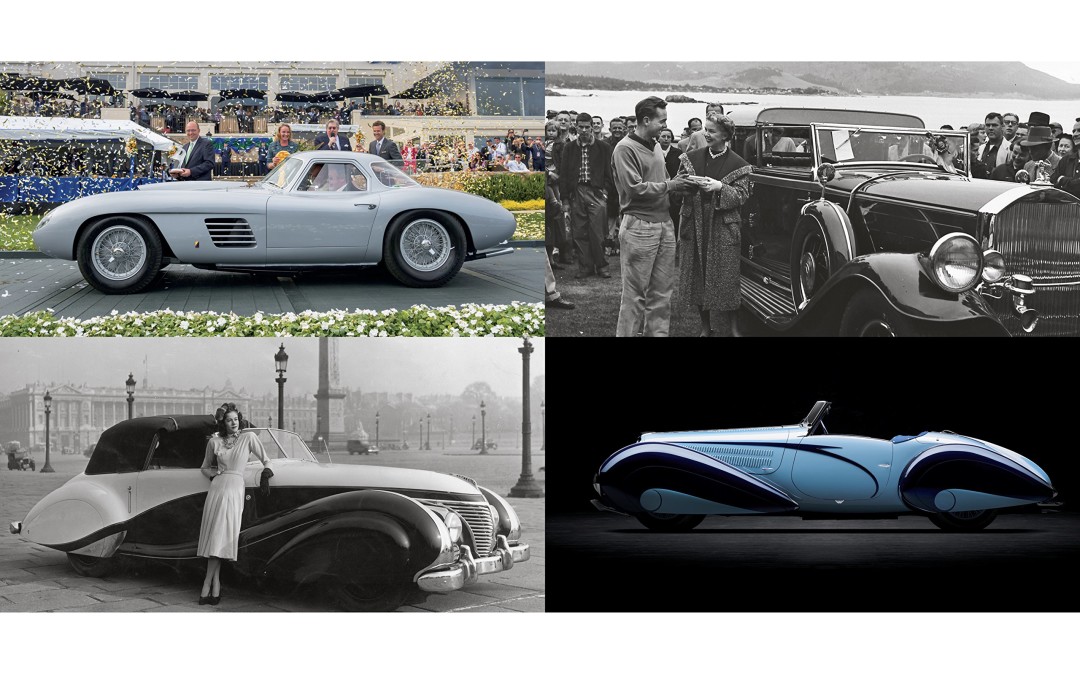
From its earliest moments in Paris to the 18th Fairway at Pebble Beach, from Blenheim Palace in England and on to the Far East, the Concours d’Elegance has long been the pedestal upon which the collector car world has placed its automotive idols. In Concours Retrospective, author Richard Adatto takes you from a time when horseless carriages were adorned with flowers to the modern day phenomenon where the automobile as an art form now commands a global audience. Sandra Button introduces the book while Dennita Sewell, Fashion Curator at the Phoenix Art Museum presents the longstanding connection between couture and concours. Illustrated with more than 200 archival photographs, recent images by Ron Kimball, Tim Scott , Winston Goodfellow and Dirk de Jager and modern studio photography by Michael Furman, Concours Retrospective will lead you on a grand tour of automotive excellence.
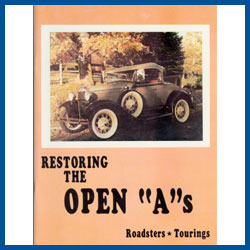
This book concentrates on the Roaster and Touring (Phaeton) cars. It provides a comparison of changes between the years 1928-1931. Photos are all taken from original Model A’s. Covers the years 1928-1931 70 pages with over 110 photos.























